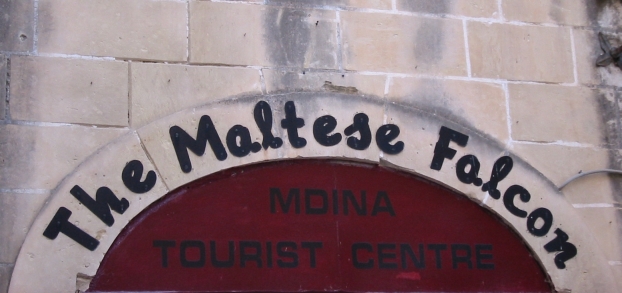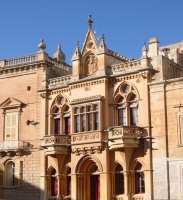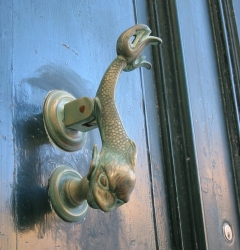

In 1530 the Spanish Emperor or Charles V ceded Malta to the
Order of St. John in exchange for an annual rent of one live falcon.
Alas, the Maltese falcon has been hunted into extinction after
the last known pair disappeared in the mid-1980's.
On our walks on the island of Gozo the shell casings left behind by
the hunters were all that remain.
Malta has a rich history dating back to c. 5000 BC. Many pottery relics from the Neolithic period can be found in the excellent Museum of Archaeology in Valletta. More artifacts are also on display in the Archaeology Museum in the Citadel in Victoria on Gozo. My favorites include the pair of heads that look like George and Martha Washington and a piece of bone that resembles a ruler.
As early as 3600 BC the early inhabitants of the Maltese Islands were building impressive temple structures like the ruins at Ggantija on the island of Gozo.
Up close, one can see carvings on the rocks. A common pattern is one with a swirl. There's also plenty of graffitti.
Tarxien, the last of the temple building phases, ended around 2600 BC (about the same time the Great Pyramid in Egypt was built). The Tarxien Temples were my favorites of the ruins in Malta. The important artifacts have been moved to the safety of Valletta's Museum of Archaeology, but replicas of some of the important finds have been placed around the temple site.
The inhabitants of these early temple building phases disappeared
and it is not known what happened to them. Theories range from
invasion to mass suicide. During the later Borg in-Nadur phase, building
shifted to a more hostile climate with fortified hilltop settlements.
The capital of Malta, Valletta was placed on the
World Heritage List in 1980.
The city was built after the Great
Siege of Malta in 1565, which checked the advance of Ottoman power in
southern Europe, it was named after Grand Master de la Valette
of the Knights of St. John.
The knights had a long series of grand masters, then the island of
Malta was taken by
the French in 1798, but a Maltese revolt against the French
garrison led to Valletta's seizure by the British in 1800. After 1814
the city became a British Mediterranean naval and military base.
Its prime location in the Mediterranean
caused it to be subjected to severe bombing raids during World
War II and after withstanding another great siege the entire
islands population was awarded the highest British civilian
award, the George Cross.
Malta became an independent democratic republic in 1974.
They don't skimp on the
door hardware in Malta.
Valletta


Fort St. Elmo
Fort St. Elmo seems a prime candidate for a movie set, either a
spaghetti western or some chase/shoot-em-up would work well
in the narrow corridors. It was, in fact, used for some of the
prison scenes in Midnight Express.
The fort serves as
the offices of the police academy, but is open to visitors on
weekend afternoons.
Island of Gozo
We spent half of our time in Malta on the small island of
Gozo. We took the ferry from Sa Maison near Valletta to the Mgarr
Harbor on Gozo which was a pleasant way to see the large island
of Malta during the one hour voyage. On the way back to Valletta,
we made the quicker crossing at the channel between the two islands
and took the bus back to Valletta. You really get your money's worth
for the 20 cent bus fare, as it was quite an exciting ride!
On Gozo we stayed at the 5 star L'Imgarr Hotel that overlooks
the harbor. Rates during the off season are very cheap and the
board option includes excellent meals.
The time spent on Gozo was relaxing and consisted mainly of short walks during the day. There are a few places to visit including a quaint folklore museum in Victoria. One church also had a nifty fake dome painted on the ceiling.
A longer hike takes one to the cool landscape around Dwerja point.
By far the best place we visited while on Malta was the Hypogeum at Hal Saflieni near Paola. Dating back to c. 3200 BC, the Hypogeum is an immense underground temple or tomb complex. The fragility of the internal microclimate has restricted access to a limited number of visitors (approx. 10/hour during a typical 7-8 hour day period). We were quite lucky in being able to visit the site, due to a clerical error, we had mistakenly been reserved a space at a time when the site is normally closed. Fortunately, the curator was on hand, and gave us a personal tour of the place.
We travelled with our friends Dave and Tracey on this trip.
Lynn Salmon <>{